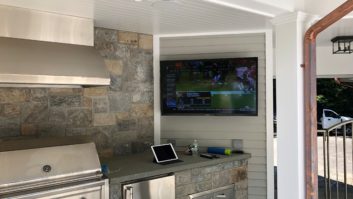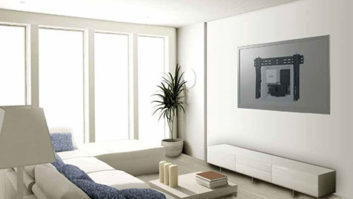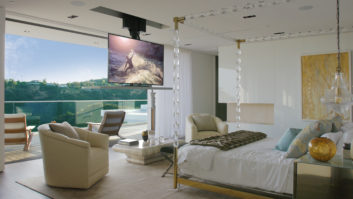This Integration Guide was sponsored by Draper as a supplement to Residential Systems, February 2016
In the early 2000s, motorized mounts and lifts animated many CI industry exhibition show floors. Stretching in and out, lifting up, and in many cases discretely hiding televisions and projectors, the mounts and lifts of this period, while innovative, were also a bit bulky and more expensive than their stationary counterparts.
“When Future Automation originally started out in the United Kingdom as a custom installer more than 15 years ago, we found that the motorized lifts and mounts that we were buying from other companies to install ourselves were poorly designed, noisy, and in some cases, simply unsafe,” said Ollie French, commercial director at the company. “This was due to the home automation market being so new that the solutions being provided were very industrial bits of kits and not well suited for home use. This is a large part of the reason that Future Automation moved from being a custom installer to being a manufacturer. The lifts and mounts on the market now are much quieter, safer, and perfectly designed to integrate seamlessly into the home of the future.”
Today, while there are not as many motorized mounting solutions as in the past, integrators now have available to them solutions that fall in line with the industrial design changes from many consumer electronic components, which means more refined lift and mount solutions that work with much smaller and thinner AV devices.

Nexus 21’s Model L-45 motorized lift continues to enjoy success, but citing increased demand for ceilingdrop-down applications, the company’s CL-65 is proving just as attractive to integrators.
“Over the past few years, motorized lifts and mounts have been almost completely reinvented, with the addition of some great improvements,” noted Cory Lovett, president of TV lift manufacturer, Nexus 21. “Gone are the days of overly large, unwieldy rack-and-pinion machines that required special handling and extra man hours for installation. Today’s sleek motorized solutions are lighter, thinner, and stronger, thanks to advances in technology that have improved in line with the development of thinner TV screens. These motorized products move faster, make less sound, and are highly reliable.
“In the current custom integration landscape, it’s easier than ever to bring the added dimension of motion-based products to projects of any size, with the benefits of memorable differentiation and strong dealer profit margins,” Lovett continued. “Most of today’s motorized systems also carry stronger warranties than in the past. Nexus 21 offers 10 years of full replacement coverage on all of its lifts, raising confidence that the lift will not need after-sale service.”
MOTION OPTIONS
As modern tastes continue to lean toward more discrete products, animated mounts and lifts have become essential complements to high-end AV integration projects. Future Automation’s, QA2 (Quad Arm), for example, is fully automated, bi-directional articulated TV mount that moves a 75-inch screen out up to 32 inches and swivels more than 70 degrees, making it an integrator favorite.




Since the early days of Future Automation, lifts and mounts on the market have become much quieter, safer, and perfectly designed to integrate into the home of the future.
“Even though the bracket spends most of its life hidden behind the screen, we designed the QA2 to seamlessly blend into any luxury environment, with design features such as beautifully machined aluminum and polished stainless steel finish,” French explained. “We find that lots of installers are using the QA2 or the larger QA2- 60 for recessing large screens in rooms where multiple viewing angles are required or they are being used as part of a larger install when combined with one of our Sliding Panel Systems.”
Nexus 21’s Model L-45 motorized lift continues to enjoy success, but citing increased demand for ceiling-drop-down applications, the company’s CL-65 is proving just as attractive to integrators.
“As with all of our motorized lifts, CL-65 is a standard product with built-in adjustability to cover a range of sizes, so we have eliminated the cost and long lead times associated with custom orders,” Lovett said. This particular lift is a natural fit for custom projects, due to the fact that the installation requires only about six inches of in-ceiling height, and it allows designers to orient furnishings and other décor in a living space as desired, while adding the TV from above without the need to re-orient the décor of the room. This lift model, like all Nexus products, is simple to integrate and is compatible with all brands of control systems.

iRoom has carved out a niche for itself in the mounting solutions category: creating mounting solutions suitable for Apple products.
In the early 2000s, Draper underwent a design phase to make its product offerings smaller and more compact—bringing its lifts in line with the shrinking size of projectors on the market at the time. The company’s latest projector lift line, the AeroLift, continues in that vein. The AeroLift 25, soon to be AeroLift 35, was designed specifically for the residential market. The lift can fit within 16-inch floor joists and is only 4 inches tall before you add the projector.
“It’s tiny!” said Amy Madden, Draper’s residential market manager. “It has recently been going through a face lift that will expand the weight capacity from 25 to 35 pounds, and it will soon be UL listed.”
iRoom has carved out a niche for itself in the mounting solutions category: creating mounting solutions suitable for Apple products. This has included incorporating a fully programmable keypad into the company’s iDock line (which includes the in-wall solution iBezel, and iTop for table tops)—the advantages of which iRoom president Chris Lehnen said are ease of use, cleaner aesthetics, and lower costs. The company’s miniDock has also been popular with integrators.
“Integrators and end users alike are impressed with the flush profile, glass bezels and, of course, motorization,” Lehnen said. “Motorized miniDock is your best ‘bang-for-your-buck,’ series with iRoom at $699 MSRP. Many integrators place motorized (removable) docks in common areas and fixed solutions in secondary zones.”
MOVING FORWARD

Draper AeroLift 25, soon to be AeroLift 35, was designed specifically for the residential market.
As integrators continue to take on projects that move beyond AV entertainment installations into more networked home applications, motorized mounts and lifts will likely be enlisted to go beyond their noted duties as well as be controlled by mobile devices. Draper, for example, has noted that it is selling more electric recessed screens than ever in direct correlation to increased resolutions (4K and 8K), with motorized mounts acting as a perfect solution to hiding all of that equipment.
“Projectors are actually getting a bit larger again with the advent of laser technologies,” Madden noted. “That makes lifts even more attractive. I see that trend continuing. Just like screens, lifts with the proper secondary controls can interface with anything. I have no doubt that you could use an app on your phone to lower your screen and lift, turn on your projector, pop your popcorn, maybe even pour your beer… then be ready to kick off your shoes and relax when you walk in the door.”
Lovett believes that in the next five years motorized products will continue to play a strong role wherever choice and location flexibility are needed with TV placement. “This includes both indoor and outdoor locations, and even kitchens for small screens and hidden storage,” he added. “With controls and interfaces that easily allow for full integration and automation, the motion-based concealment and positioning of TV screens will keep pace with the needs of designers and integrators in creating the smart solutions that are expected by their clients. Advances in software, in-line position sensors, and IP addressability will make motorized lifts and mounts a reliable and memorable addition to any project that includes TV screens, well into the future.”





